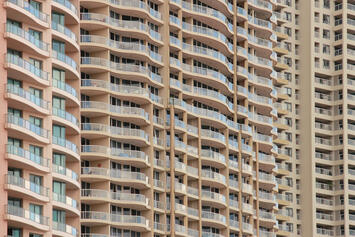
One of the (many) furphies that gets aired (frequently) in discussions around housing affordability is that we can build ourselves out of the problem by building a lot more high–density housing units rather than typical detached suburban houses.
In fact, the opposite is likely to happen should we attempt this course of action. Here’s why.
First, the reality of construction economics is such as that every square metre of space in a high–rise apartment building is more expensive — roughly double or more — than the same square metre of space built in a detached single level home.
The traditional “sticks and bricks on slab” construction of detached suburban housing has been incredibly efficient over a very long period of time. As a building form, it lacks complexity (despite recent moves to introduce it via new standards). It’s even been said that in post–World War II Sydney, as many as a third of the new suburban homes were by owner–builders.
Despite recent and rapid cost escalations, the build cost per square metre of a low–set detached suburban house is still around $1700 for the modest spec home. Not including the land, you can still find project home builders who will give you the keys to a brand new three bedroom, two bathroom house from around $220,000 to $300,000 — and that’s for roughly 200m2 under roof.
It’s a different story for multi storey apartments. These are more complex structures, with a good deal more going into them — more than just concrete and reinforced–steel slabs (which are themselves more expensive than timber frames or bricks for a low set house). There are also lifts, fire systems, standby generators, deep foundations and excavations for basement car parks… it’s quite a list. Building them also takes a lot longer than a standard house and involves at least one tower crane, sometimes more.
All of which means each square metre of floorspace in that high rise unit tower is going to cost around $4,000/m2 for a structure of basic design. This applies to the whole floor of course — corridors and common areas included. The cost per metre for the actual living space, developers and QS’s tell me, is closer to $5,000 per square metre. So a unit of 120 square metres will cost around $600,000 just to build. Not including the land or other development costs. This is around half the size but twice the cost of our detached new stick–and–brick example above — which includes builder margin.
Market prices need to factor in land and other development costs. The new low set detached house and land package will set you back from around $500,000 to $700,000, depending on location. (This is the discount end of the market of course). New home units however are well above this. Try finding a new three–bedroom apartment for $700,000 in Brisbane. Many are priced at $1m or more, even those well away from the urban core. (Spend a little while searching on realestate.com.au and see for yourself!).
Read the rest of this piece at The Pulse.
Ross Elliott has more than thirty years' experience in urban development, property and public policy. In addition to his consulting work he is Chair of the Lord Mayor of Brisbane's Better Suburbs Initiative, a director of The Suburban Alliance, and District Chair of the ULI in Brisbane, Australia. His past roles have included a number of industry leadership positions. He has written and spoken extensively on a range of public policy issues centering around urban issues, and maintains his interest in public policy through ongoing contributions such as this or via his monthly blog, The Pulse.
Photo: Jamie Muchall via Flickr under CC 2.0 License.













In addition to the mentioned affordability problems
I agree with the article, however there are a few additional points not mentioned. The value of low density land is much lower than that of higher density zoning. For example take an area in which raw land has a density of 3 homes per acre vs. 30 homes per acre as per the images of this article and you will find that because the land can yield far more units, the price of that raw land skyrockets. I work for a lot of developers (over 300) and there are two kinds. There are developers who build what we design and there are flippers who entitle land (often from lower to higher density). Those 'flippers' often make a fortune on rezoning land. That fortune is in profits because of the increased value due to the increased density. So who pays for that profit? The end user - those that rent the units. Another increased impact is the enormous amount of space needed for the renters to park their cars. Here in Minnesota, for the most part modern apartments park below the buildings in protected structures, but in other areas especially with high water tables (Texas and Florida) the parking consumes an enormous amount of extra paved surface - which not just cost in paving, but the costly extra acreage for those parking lots that also add to impervious run-off.